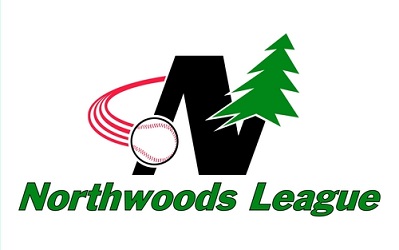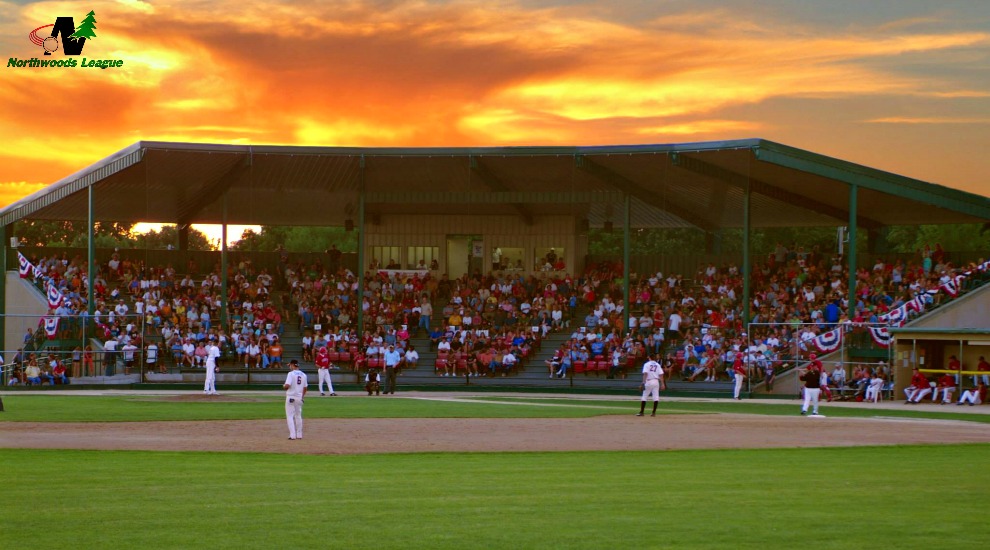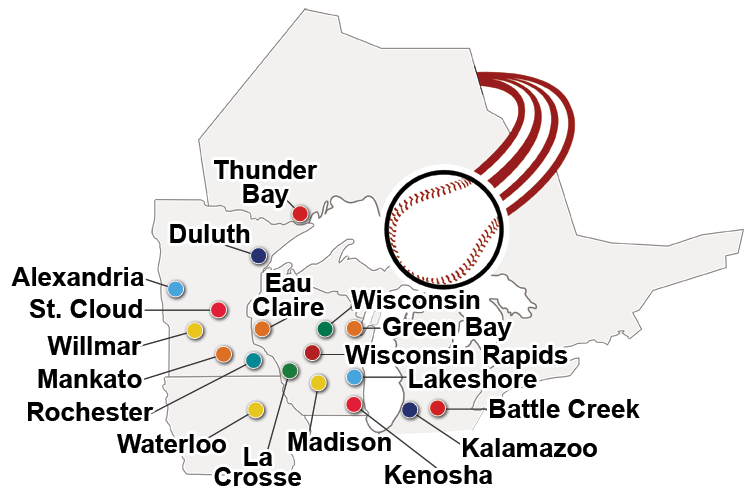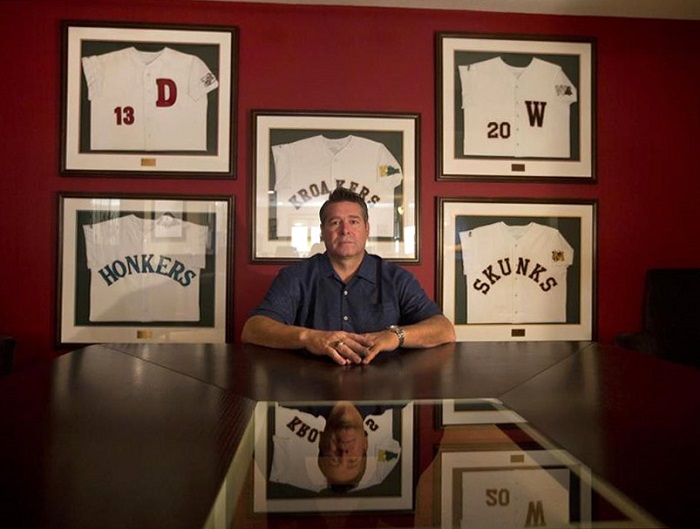It seems the more I check into the background of Dodger minor league players, the more I am coming across a connection to the Northwoods League. Most recently I found that Loons pitchers Garrett Harrison and Alex Hermeling both had been signed by the Dodgers in 2015 as undrafted college players out of the Northwoods League.

Perhaps the best known and most productive summer college league has been the Cape Cod Baseball League which has been in existence since the fourth of July in 1885. An amateur league, it affiliated with the NCAA in 1964 so its rosters include only young college players – freshmen, sophomore and junior players – from institutions with four year programs.
The Alaska Baseball League is another well known collegiate league that has patterned itself after the Cape Cod Baseball League. One of its most unique features is that it is possible to play baseball under the midnight sun. It has grown in popularity and production since its inception in 1974 and also claims to be the number one collegiate league in the United States.
Presently there are as many as 40 summer collegiate leagues, depending on the list that has been referenced. Stats. Style. Score has gone one step further and produced a “Top 10 Collegiate Baseball Summer Leagues” list. While the Cape Cod Baseball League has an expected number one ranking, the much less well known Northwoods League stands in a rather respectable fourth place.

The Northwoods League is very popular in areas where there are no major or minor league teams to watch.
(Image courtesy of kirkwoodeagles.com)
The Northwoods League now preparing for its twenty-second year of operation is a collegiate summer baseball league with a difference. As with all collegiate summer leagues its teams are made up of the best college players that it can attract and all players in the league must have NCAA eligibility remaining in order to participate. That is, seniors are not eligible to play in the league and players are not paid so as to maintain their college eligibility.
The Northwoods League, comprised of 18 teams and looking to add Bismarck, North Dakota in 2017, is located in the Northwoods region of the Upper Midwestern United States and Southern Canada. Although it presently covers Iowa, Michigan and Illinois most of its teams are located in Minnesota and Wisconsin which have five and eight teams respectively. The lone Canadian team is located in Thunder Bay, Ontario.

Northwoods League Map
(Image courtesy of northwoodsleague.com)
So what is the difference in the Northwoods League? It is a wooden bat league but that doesn’t make it different from a number of other collegiate leagues. The big difference is that the league has striven to simulate a professional minor league experience for its young players in which they have the opportunity to play under similar conditions experienced by minor league players.
The Northwoods League has a 72 game schedule played in 76 days from late May until mid-August. The 18 teams are divided evenly in a Northern and Southern Division with a mid-season All-Star game and season ending play-offs. The season itself is broken into two halves, with the winners of each half in each of the two divisions meeting first in a playoff to determine a divisional champion. The divisional champions then meet in a best-of 3 playoff for the league championship.
Many of the teams play in ballparks formerly occupied by professional minor league teams from the Midwest, Prairie and Northern Leagues that couldn’t sustain a minor league franchise. The Northwoods League has tried to fill that void and has established improved stability while providing smaller communities with a high quality product and good competitive baseball. As part of that commitment another definite difference is that although the players are not paid it is a for-profit league with paid staff, advertising, marketing and stadium improvement.
The Northwoods League has grown like no other collegiate league both in terms of the number of teams and , in its case, paid attendance. In its inaugural season in 1994 the league drew 69,000 fans. In 2014 the league attendance passed the 1,000,000 mark for the first time. The Coastal Plain League at 422,000 finished a distant second in attendance. The growth in attendance perhaps may be attributed to a number of facts. The league plays a longer season with more games than other collegiate leagues. However, that alone could not explain the spike in attendance which is more likely a reflection of the league’s emphasis on and expertise with business as well as player development. The plan to use former minor league parks and establish local loyalties to home teams has filled a void left by minor league teams that had to move on.
The Northwoods League is the brainchild of Dick Radatz Jr. Unlike his father who as a Boston Red Sox pitcher had man handled Yankee slugger Mickey Mantle like he was a minor leaguer, the younger Radatz had his dreams of being a MLB player dashed with a broken shoulder and broken collarbone while still in college.

Dick Radatz Jr.
Photo credit – Stan Grossfeld)
He went on to get a Master’s Degree in Sports Administration at Ohio University. Following that he launched a baseball executive career in the Florida State League spending one spring at the Dodgers Spring training complex in Vero Beach and next becoming the General Manager of the Red Sox team in the league. He earned the Florida State League Executive of the Year in 1986 but a short three years later he was let go after disagreeing with his superiors on player development.
In 1994, he co-founded the Northwoods League, a for-profit summer collegiate baseball league in the Upper Midwest to aid in college player development and to seize an opportunity to bring quality baseball back to small town America.
Radatz acknowledges that many of the best college players still turn to the prestigious Cape Cod Baseball League following their college season. However, without question, he believes the gap is rapidly closing and also truly believes his league does a better job of preparing players for the majors than the Cape Cod League does.
According to a study Radatz commissioned, Northwoods League pitchers have a lower ERA in their first year of professional baseball than Cape Cod pitchers.
“The primary reason is that they get to experience pitching in front of big crowds in minor league venues,” said Radatz. “They also get used to five-man rotations and long bus rides. All the things that are going to go on in a professional baseball player’s life, they experience here. We really feel like we’re the leader in the field. We play more games and play in better venues. Our experience is more closely related to that of entry-level minor leagues.”
“The Cape is more of a summer league but this is more of a minor league feel,” said Craig Caufield, a Memphis University right-hander who during his time in the Northwoods League was a closer for the La Crosse Loggers. “You play four times a week there; you play seven times a week here. The travel sucks, it’s rough, but that’s what it’s like in the minor leagues, so it’s just preparing us for the future.”
Dodger outfielder Andre Ethier was a member of the Rochester Honkers in the Northwoods League the summer of 2002. Loons Garrett Harrison and Alex Hermeling are the most recent Dodger graduates of the league.
Northwoods League President Dick Radatz and his team have accomplished much with the Northwoods League in a relatively short period of time. However, you have to believe he will not be satisfied until his league is the number one ranked collegiate league and he has even further developed the minor league entry plan for the stream of young college players flocking to the Northwoods.




 April 20th, 2016 at 8:00 am
April 20th, 2016 at 8:00 am  by Harold Uhlman
by Harold Uhlman  Posted in
Posted in 

Wow! Who knew?
GREAT article, Harold (again). I can honestly say I had never heard of the Northwoods League before reading this piece. It is yet another example of just how popular baseball is in our respective countries.
Thanks!